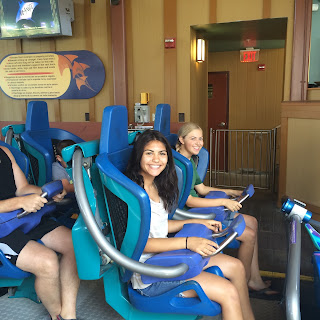Spotlight: In the early spring of 1846, thousands of Mormon pioneers were slowly making their way across Iowa Territory after abandoning their homes in Nauvoo, Illinois. Their leader,
Brigham Young, sent a messenger to
President James K. Polk, asking for federal assistance. The messenger, Jesse Little, met with Pres. Polk just eight days after Congress declared war against Mexico. In response, Pres. Polk offered to aid the pioneers by employing 500 of their best men in a battalion that would serve under Colonel Stephen W. Kearny, Commander of the Army in the West. At the urging of Brigham Young, more than
543 men between the ages of 18-45 enlisted in the Battalion under the command of newly promoted
Lt. Colonel James Allen at
Council Bluffs, Iowa with the provision that the Mormons could encamp on United States land over the winter.
Five companies of soldiers were formed, and marched out of Council Bluffs on 20 July 1846. Accompanying the men were 33 women, 20 of whom were employed as laundresses, and 51 children. The soldiers were outfitted at
Fort Leavenworth, Kansas. Rather than keep the money themselves, most of the soldiers sent the bulk of it to the beleaguered pioneers who used it to purchase much needed supplies for their trek west. When Colonel Allen fell ill at Fort Leavenworth, he sent the Battalion on to Santa Fe under the command of
Captain Jefferson Hunt of Company A. When Colonel Allen died,
Lt. AJ Smith was sent from Fort Leavenworth to take command of the Battalion. The transition proved to be a rocky one as the soldiers chaffed under Lt. Smith's dictatorial style. The march was a difficult one and many of the soldiers fell ill due to excessive heat, insufficient supplies, improper medical treatment and long marches. A sick detachment was sent to Fort Pueblo, CO. When they reached
Santa Fe,
Lt. Colonel Philip Cooke assumed command and sent another sick detachment, along with the remaining women and children to join the first one at Fort Pueblo. A final third detachment was finally sent before winter set in.
On their way to
Tucson, AZ, the Battalion was attacked by a herd of wild cattle. In the
Battle of the Bulls, a number of bulls were killed and two men wounded. Ironically, this would be the only battle the Battalion would encounter on their 2,000 mile march to California. The Battalion arrived at
Mission San Diego in
January 1847 after one of the longest military marches in history. Although some soldiers were assigned to accompany Colonel Kearny back to Fort Leavenworth, most were assigned garrison duty in San Diego, San Luis Rey or Los Angeles for the remainder of their year-long enlistment. Many helped build the first
San Diego Courthouse,
Fort Moore in Los Angeles and several other military and civic structures and roads in southern California. Although 81 men chose to re-enlist, and others sought employment from men like John Sutter in northern California, the majority migrated to the
Salt Lake Valley to be reunited with their families who were gathering there.
Location: The Mormon Battalion Historic Site is located at
2510 Juan St. at the edge of Old Town San Diego.
Cost: free
Time: Open daily from 9 am - 9 pm. Plan on staying between 1-2 hours.
Description: Formerly known as the Mormon Battalion Visitors' Center, the Mormon Battalion Historic Site was completely
refurbished in 2010. The building was constructed in the colonial Spanish architectural style, and visitors are greeted by enthusiastic hosts dressed in period costume. The
interactive exhibits allow actual members of the Battalion tell their own stories using high-tech digital technology. Visitors travel from room to room, which are decorated to appear like: an encampment, Fort Leavenworth, and the San Diego Courthouse. After experiencing the tale of the Battalion, visitors are free to explore other areas of the site and participate in activities such as:
panning for gold, making bricks, dressing up in period costumes, pumping water, drawing it from a well and
examining authentic artifacts. In the
Research Room, visitors can discover whether or not they are related to any members of the Battalion.
 |
| "On the trail" with the Battalion |
 |
| watching the participants tell their own story |
 |
| Panning for gold |
 |
| Honorary members of the Battalion |
 |
| Panning for gold (digitally) |
Rating: 4 1/2 stars (out of 5)
Things You Should Know: - The guides are typically older couples who are volunteer missionaries from the Church of Jesus Christ of Latter-Day Saints (the Mormons) who will answer any of your questions about the Battalion or their beliefs.
Nearby: Old Town San Diego State Historic Park, Heritage Park, Bazaar Del Mundo, SeaWorld




















































